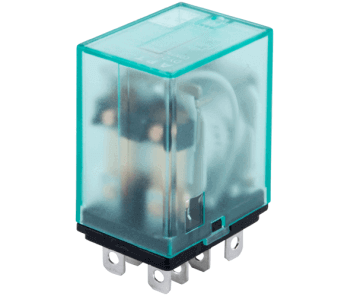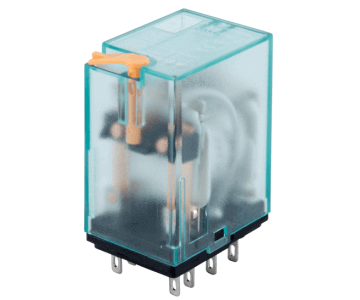1. What is a relay?
A relay is the device that opens or closes the contacts to cause the operation of the other electric control. Relays control one electrical circuit by opening and closing contacts in another circuit. Relays are generally used to switch smaller currents in a control circuit and do not usually control power consuming devices except for small motors and Solenoids that draw low amps. Nonetheless, relays can "control" larger voltages and amperes by having an amplifying effect because a small voltage applied to a relays coil can result in a large voltage being switched by the contacts. In addition, relays are also widely used to switch starting coils, heating elements, pilot lights and audible alarms.
2. Why do we use a relay?
A very common reason, especially in an industrial application, is for voltage and current requirements. Many machines and electrical equipment use a higher voltage to run. To make it safer for the operators, we use a low voltage and current for our controls. For example, you want not someone pushing a button with high voltage attached to it. When we use a relay, the contacts that close can be rated for much higher current.
3. How do relays work?
A relay works on the principle of an electromagnetic attraction. When the circuit of the relay senses the fault current, it energises the electromagnetic field which produces the temporary magnetic field. This magnetic field moves the relay contacts for opening or closing the connections. The small power relay has only one contact, and the high power relay has two, three and four contacts for opening the switch.
The inner section of the relay has an iron core which is wound by a control coil. The power supply is given to the coil through the contacts of the load and the control switch. The current flows through the coil produce the magnetic field around it. Due to this magnetic field, the upper arm of the magnet attracts the lower arm. Hence close the circuit, which makes the current flow through the load. If the contact is already closed, then it moves oppositely and hence opened the contacts. Extended learning: (What is the principle and function of the relay?)
4. What is kind of contactor?
According to the working principle of the relay, Electromagnetic Relay,Solid relay, Static Relay,Over-current Relay, Thermal Relay.
5. What is an Electromagnetic Relay?
Electromagnetic relays are those relay which operates on the principle of electromagnetic attraction. It is a type of a magnetic switch which uses the magnet for creating a magnetic field. The magnetic field uses for opening and closing the switch and for performing the mechanical operation. Extended learning: (What are the commonly used electrical components in the distribution cabinet?)
6. What is a Static Relay?
Static Relay which does not contain any moving parts is known as the static relay. In such type of relays, the output is obtained by the static components like magnetic and electronic circuit etc. The relay which consist static and electromagnetic relay is also called static relay because the static units obtain the response and the electromagnetic relay is only used for switch operation.
7. What is an Over-current Relay?
Over-current relay which is defined as the relay, which operates only when the value of the current is greater than the relay setting time. It protects the equipment of the power system from the fault current.
8. What is a thermal Relay?
A thermal relay works on the principle of the thermal effect of electrical energy. The bimetallic strips, heating coils and the current transformers are the important parts of the thermal relay.
What is a solid state relay?
9. What is a Solid-state Relay?
A solid-state relay, Abbreviation SSR, that is an electronic switching device. It switches on or off when a small external voltage is applied across its control terminals. SSR consist of a sensor which responds to an appropriate input, a solid-state electronic switching device which switches power to the load circuitry, and a coupling mechanism to enable the control signal to activate this switch without mechanical parts. The relay may be designed to switch either AC or DC to the load. It serves the same function as an electro mechanical relay, but has no moving parts.

